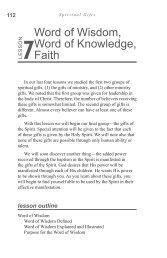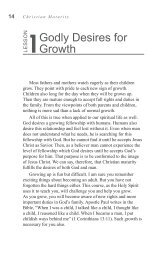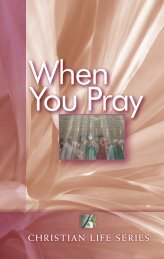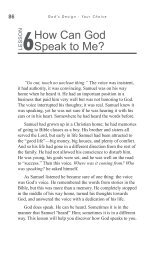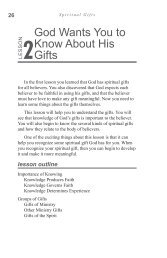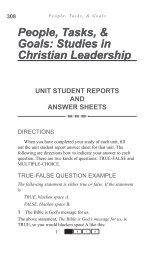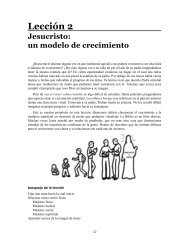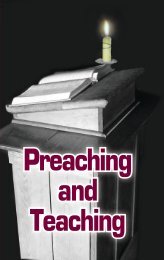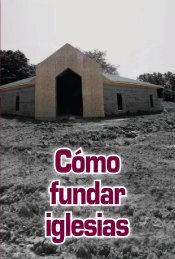Topical Method of Study - GlobalReach.org
Topical Method of Study - GlobalReach.org
Topical Method of Study - GlobalReach.org
You also want an ePaper? Increase the reach of your titles
YUMPU automatically turns print PDFs into web optimized ePapers that Google loves.
196<br />
LESSON<br />
9<br />
<strong>Topical</strong> <strong>Method</strong> <strong>of</strong><br />
<strong>Study</strong><br />
A topical Bible study is a study that deals with a specific<br />
subject in the Bible. The main topic or subject <strong>of</strong> the Bible is<br />
redemption through the blood <strong>of</strong> Christ! The Old Testament<br />
explains how God related Himself to our fallen human race<br />
through Israel. Israel’s sacrifices, feasts, and <strong>of</strong>ferings all<br />
pictured, in one way or another, Christ the Savior to come.<br />
He came when the time was right. The New Testament is the<br />
record <strong>of</strong> His coming. It tells <strong>of</strong> the events that followed His<br />
coming and those which will follow as time moves on. Other<br />
Bible topics support and explain the main topic.<br />
You learned in Lesson 8 that people are topics in<br />
biographical study. But there are other topics besides people in<br />
the Bible. In Scripture you can read about music, occupations,<br />
customs, plants, animals, politics, geography, right rules for<br />
living, and many, many other topics that are both interesting<br />
and valuable to study. Learning the procedure for a topical<br />
Bible study will help you gain a better understanding <strong>of</strong><br />
the Bible.
To p i c a l M e t h o d o f S t u d y<br />
197<br />
lesson outline<br />
Introduction to <strong>Topical</strong> <strong>Study</strong><br />
Examples <strong>of</strong> <strong>Topical</strong> Studies<br />
Nature Topic: the Sparrow<br />
Theological Topic: God’s Nature<br />
Ideas for Further <strong>Study</strong><br />
Procedure for the <strong>Topical</strong> <strong>Method</strong><br />
Step 1: List Occurrences<br />
Step 2: Classify into Categories<br />
Step 3: Examine Context<br />
Step 4: Summarize Each Category<br />
Step 5: Compare Summary Statements<br />
Step 6: Summarize Entire Outline<br />
<strong>Topical</strong> <strong>Study</strong> <strong>of</strong> Ephesians<br />
lesson objectives<br />
When you finish this lesson you should be able to:<br />
1. Describe the relationship between visible things and<br />
invisible qualities in topical Bible study.<br />
2. Describe “things” and “qualities” as topics for Bible study<br />
and give examples <strong>of</strong> each <strong>of</strong> the two categories.<br />
3. List and explain the six steps in making a topical study.<br />
4. Make a topical outline from Ephesians 4, 5, and 6, using the<br />
topic: “Acceptable Words.”<br />
learning activities<br />
1. Read the opening section, outlines, and objectives.<br />
2. Learn the meanings <strong>of</strong> key words that are new to you.<br />
3. Read the lesson development and respond by following the<br />
instructions in each question as you come to it.<br />
4. Many <strong>of</strong> the answers will require more space than can be<br />
allowed in your textbook; you will need your own notebook<br />
for all except the very short answers.
198 U n d e r s t a n d i n g t h e B i b l e<br />
5. Take the self-test at the end <strong>of</strong> the lesson and check your<br />
answers.<br />
key words<br />
accountable occurrences random<br />
erroneous preconceived<br />
lesson development<br />
<strong>Topical</strong> <strong>Method</strong> <strong>of</strong> <strong>Study</strong><br />
Objective 1. Describe the relationship between visible things and<br />
invisible qualities in topical Bible study.<br />
Our list <strong>of</strong> Bible topics in the first part <strong>of</strong> this lesson<br />
included both the visible and the invisible. We find in Romans<br />
1:20 a relationship between them which is valuable to topical<br />
Bible study: “Ever since God created the world, his invisible<br />
qualities, both his eternal power and his divine nature, have<br />
been clearly seen; they are perceived in the things that God has<br />
made. So those people have no excuse at all!” This Scripture<br />
explains that God created the very nature that surrounds us,<br />
with the intent that we could learn about Him through our<br />
observation <strong>of</strong> it. God planned Israel’s location in Palestine<br />
(Deuteronomy 1:8). He planned its building materials (stones<br />
that would last for centuries to witness to the truth <strong>of</strong> His<br />
word). He planned its natural resources, the lay <strong>of</strong> its land, and<br />
even its climate. All these things have been used by God to<br />
illustrate truth in His power and nature.<br />
The early and latter rains which water the crops <strong>of</strong> Palestine<br />
are the autumn rains (early) and spring rains (latter). These<br />
rains are used as significant illustrations in Scripture. (See<br />
Proverbs 16:15, Zechariah 10:1, James 5:7.) Any topic that is<br />
treated or mentioned in the Bible is a possible topic for you<br />
to study. This would include not only such things as clothing,<br />
housing, foods, etc. but also words; that is, how certain key<br />
words are used in Scripture. Your study would include themes<br />
such as faith, prayer, the second coming <strong>of</strong> Christ, and topics
To p i c a l M e t h o d o f S t u d y<br />
199<br />
concerning Christian living. The study you will be making in<br />
the last section <strong>of</strong> this lesson, in the book <strong>of</strong> Ephesians, is <strong>of</strong><br />
the last type. It is a study on an important aspect <strong>of</strong> Christian<br />
living: acceptable words.<br />
Application<br />
1 Write T in the blank space before the statements that are<br />
true and F before false statements.<br />
. . . a God has created nature in a haphazard or unplanned<br />
way.<br />
. . . b There is no relationship between God’s eternal truth<br />
and what can be seen in nature.<br />
. . . c God purposely created nature in such a way that it<br />
would illustrate both His power and His divine nature.<br />
. . . d The homeland for the people <strong>of</strong> Israel was chosen in a<br />
random way.<br />
. . . e God particularly planned and selected Palestine as the<br />
homeland for His people Israel.<br />
. . . f James 5:7 uses the autumn and spring rain <strong>of</strong> Palestine<br />
to illustrate the value <strong>of</strong> patience.<br />
There will be great differences in the amount <strong>of</strong> information<br />
available about various topics in the Bible. For some, there may<br />
be a wealth <strong>of</strong> information in just a chapter or a passage. For<br />
others, it may be necessary to glean information from many<br />
books in both Testaments to get the fullest possible meaning<br />
from the study. The more comprehensive your study, the longer<br />
it will take. I have heard <strong>of</strong> a man who is doing his own study<br />
<strong>of</strong> the Holy Spirit, using all <strong>of</strong> the Bible. This kind <strong>of</strong> study<br />
would be done using steps similar to those you will learn to<br />
use in this lesson. The study will probably take the man several<br />
years or a lifetime to do, depending on how detailed he makes<br />
it. So, the length <strong>of</strong> a topical study will depend on the amount
200 U n d e r s t a n d i n g t h e B i b l e<br />
<strong>of</strong> information to be found and the amount <strong>of</strong> time you wish to<br />
spend on it.<br />
Application<br />
2 Circle the letters before the correct completions to this<br />
sentence: The length <strong>of</strong> a topical study will depend on<br />
a) the length <strong>of</strong> the book where the topic is mentioned.<br />
b) the amount <strong>of</strong> information to be found on the topic.<br />
c) the amount <strong>of</strong> time the student spends studying the topic.<br />
A long, complete study is made much easier if you have<br />
access to a Bible concordance or a Bible dictionary. Bible<br />
s<strong>of</strong>tware is also available to speed up searches. In these<br />
concordances and dictionaries, words and topics mentioned<br />
in the Bible are listed in alphabetical order along with their<br />
Scripture references. These helps allow you to save time in<br />
finding all the places where a topic is mentioned. If such books<br />
are ever available to you, you will want to make use <strong>of</strong> them.<br />
However, topical studies can be done without such helps.<br />
In fact, it is better in shorter topical studies to do your own<br />
reading and searching for occurrences <strong>of</strong> the topic you wish<br />
to investigate. This is true because in doing your own reading,<br />
you will not only find DIRECT references to the topics, but<br />
INDIRECT references as well. Direct references are those<br />
which actually contain the specific word or phrase you are<br />
looking for. Indirect references are those which refer to the<br />
theme or general idea <strong>of</strong> your topic. These indirect references<br />
are important for a more complete understanding <strong>of</strong> your topic.
To p i c a l M e t h o d o f S t u d y<br />
201<br />
Application<br />
3 Write direct after the definition <strong>of</strong> a direct reference, and<br />
indirect after the definition <strong>of</strong> an indirect reference.<br />
a A reference which alludes to the theme or general idea <strong>of</strong><br />
the topic<br />
. . . . . . . . . . . . . . . . . . . . . . . . . . . . . . . . . . . . . . . . . . . . . . .<br />
b A reference which contains the specific word or phrase you<br />
are looking for<br />
. . . . . . . . . . . . . . . . . . . . . . . . . . . . . . . . . . . . . . . . . . . . . . .<br />
4 Circle the letters before the correct statements.<br />
a) You have to have other reference books to do a topical<br />
Bible study.<br />
b) Reference books such as a Bible concordance or a Bible<br />
dictionary can be helpful when doing a topical Bible study<br />
but are not necessary.<br />
c) In a topical Bible study, you will look only for the places<br />
where the topic is mentioned directly.<br />
d) In a topical Bible study, you will look for all the places<br />
where the topic is mentioned directly or indirectly.<br />
Examples <strong>of</strong> <strong>Topical</strong> Studies<br />
Objective 2. Describe “things” and “qualities” as topics for Bible<br />
study and give examples <strong>of</strong> each <strong>of</strong> the two categories.<br />
Nature Topic: the Sparrow<br />
You saw, in your reading <strong>of</strong> Romans 1:20, that God uses<br />
nature to teach lessons to the human family. The lowly sparrow,<br />
or sparrow-like bird, which is so common around houses and<br />
gardens in many places <strong>of</strong> the world, is used a number <strong>of</strong> times<br />
in Scripture to illustrate truth.<br />
Scholars tell us that the word sparrow is a translation <strong>of</strong><br />
the Hebrew tzippor, which seems to have been a general term<br />
for all small birds or sparrow-like species. If you had time to
202 U n d e r s t a n d i n g t h e B i b l e<br />
investigate, you would find this word used more than forty<br />
times in the Old Testament—not always translated sparrow.<br />
Sometimes it appears as bird or fowl. A corresponding Greek<br />
word occurs twice in the New Testament. These small birds are<br />
used in Scripture to illustrate how very much God cares for His<br />
children. Consider Matthew 10:29-31:<br />
For only a penny you can buy two sparrows,<br />
yet not one sparrow falls to the ground without<br />
your Father’s consent. As for you, even the<br />
hairs <strong>of</strong> your head have all been counted. So do<br />
not be afraid; you are worth much more than<br />
many sparrows!<br />
God is interested in sparrows. They are part <strong>of</strong> His creation.<br />
How vitally important it is for every child <strong>of</strong> God to have<br />
complete confidence and trust in the care <strong>of</strong> the Heavenly<br />
Father!<br />
The Psalmist uses the little bird as an illustration <strong>of</strong> sorrow<br />
and loneliness. He writes, “I am like a lonely bird on a housetop”<br />
(Psalm 102:7). These small birds are known for their<br />
congregating in groups, noisy and chattering. To illustrate<br />
the intensity <strong>of</strong> his grief, the writer has contrasted the normal<br />
surrounding <strong>of</strong> these birds to that <strong>of</strong> the one alone on the<br />
housetop.<br />
Theological Topic: God’s Nature<br />
The following is an outline <strong>of</strong> a topical study, similar to<br />
the kind <strong>of</strong> outline you will be making in your notebook for<br />
the study in Ephesians. At this point, just read the outline and<br />
look up the verses that are mentioned as you read. Notice<br />
the observations that are made for each reference. Notice the<br />
summary statement at the end. (All the references are from the<br />
book <strong>of</strong> Habakkuk.)
To p i c a l M e t h o d o f S t u d y<br />
203<br />
Topic: The Nature <strong>of</strong> God<br />
REFERENCE OBSERVATION<br />
1:2 Habakkuk cries to the Lord, but the Lord does<br />
not answer. Since God is righteous, what does<br />
failure to answer imply That God answers<br />
when ready and only then.<br />
1:5-6 God is working; God is raising up Babylonians.<br />
What does this imply with regard to<br />
Habakkuk’s complaint That God has been<br />
in the process <strong>of</strong> answering even before<br />
Habakkuk’s cry.<br />
1:12 God is from the Beginning. God is holy,<br />
eternal. He is Habakkuk’s protector.<br />
1:13 God’s eyes are too holy to look at evil. God<br />
cannot stand the sight <strong>of</strong> people doing wrong.<br />
2:1 Habakkuk expects an answer from the<br />
Lord. What does this imply That God is<br />
accountable.<br />
2:13-14 The Lord must be the ultimate end <strong>of</strong> all effort.<br />
Knowledge <strong>of</strong> the Lord will fill the earth.<br />
2:20 The Lord is in His holy temple. He is worthy <strong>of</strong><br />
reverence.<br />
3:3 God is holy and full <strong>of</strong> splendor.<br />
3:5-6 The Lord is powerful.<br />
3:13, 18 The Lord is concerned about salvation <strong>of</strong><br />
people.<br />
3:19 The Lord is strong.<br />
Summary: By nature God is personal, eternal, holy, and<br />
righteous. He is supreme in power, fair in judgment, and patient<br />
in His administration <strong>of</strong> justice, and He is the Savior.<br />
Ideas for Further <strong>Study</strong><br />
In the two subsections <strong>of</strong> the lesson that you have just<br />
read, you have examples <strong>of</strong> two kinds <strong>of</strong> topical study. As you<br />
can see they are quite different, yet both deal with a specific
204 U n d e r s t a n d i n g t h e B i b l e<br />
topic. The first example, the short study on the sparrow,<br />
is representative <strong>of</strong> the many topics <strong>of</strong> interest that can be<br />
found in the area <strong>of</strong> nature. Plants, animals and minerals are<br />
sometimes used in the Bible as illustrations and sometimes as<br />
symbols. These terms can sometimes be used interchangeably,<br />
but we will point out differences <strong>of</strong> usage between them that<br />
will help you to better understand the Bible.<br />
An illustration <strong>of</strong> a truth pictures that truth in a way which<br />
makes it easier to understand. The mustard plant is an example<br />
<strong>of</strong> such an illustration. Because the mustard plant is known<br />
for growing an unusually large plant from a very small seed,<br />
Jesus used it to illustrate truth about the Kingdom <strong>of</strong> Heaven<br />
(Matthew 13:31-32) and faith (Matthew 17:20). A symbol is<br />
something that stands for something else. A symbol has one or<br />
more qualities that remind you <strong>of</strong> the object it stands for. For<br />
example, in Daniel 2 the “head <strong>of</strong> gold” was revealed to be<br />
a symbol <strong>of</strong> King Nebuchadnezzar himself (v. 38). In Daniel<br />
8:1-8, a ram and a goat were used as symbols <strong>of</strong> kingdoms and<br />
kings who were to come.<br />
When studying topics <strong>of</strong> this type, you will use the same<br />
steps that are outlined in the next section <strong>of</strong> the lesson. In<br />
addition, you will especially note the qualities <strong>of</strong> the topic<br />
which made it appropriate to use as either an illustration <strong>of</strong><br />
truth, a symbol, or something else.<br />
Application<br />
5 Consider the following topics. Read the reference given<br />
for each one. Write either illustration or symbol in the blank<br />
following each example.<br />
a The ant (Proverbs 6:6-8) . . . . . . . . . . . . . . . . . . . . . . . . . . .<br />
b The Lamb (Revelation 6:1, 3, 5, 7) . . . . . . . . . . . . . . . . . . .<br />
c Locusts (Nahum 3:15) . . . . . . . . . . . . . . . . . . . . . . . . . . . . .<br />
d The bear (Daniel 7:5, 17) . . . . . . . . . . . . . . . . . . . . . . . . . .
To p i c a l M e t h o d o f S t u d y<br />
205<br />
In addition to those already mentioned in this lesson, some<br />
possible topics from nature might include light, water, grain,<br />
herbs (such as cumin, Matthew 23:23) and many others.<br />
The second example <strong>of</strong> a topical study that you have read,<br />
The Nature <strong>of</strong> God, deals with a topic that is a quality rather<br />
than a thing. Additional qualities that can be investigated are<br />
hope, love, faith, f<strong>org</strong>iveness, repentance, and eternal life.<br />
Application<br />
6 Circle the letters before the correct statements.<br />
a) Topics taken from nature are <strong>of</strong>ten used in the Bible as<br />
illustrations or symbols.<br />
b) Topics that are qualities rather than things are <strong>of</strong>ten used in<br />
the Bible as illustrations or symbols.<br />
c) Bible topics for possible study are quite limited.<br />
d) Bible topics for possible study are many and varied.<br />
7 List four or five possible topics that you can think <strong>of</strong> for<br />
study that have not been mentioned so far in this lesson.<br />
. . . . . . . . . . . . . . . . . . . . . . . . . . . . . . . . . . . . . . . . . . . . . . . . . . .<br />
. . . . . . . . . . . . . . . . . . . . . . . . . . . . . . . . . . . . . . . . . . . . . . . . . . .<br />
Procedure for the <strong>Topical</strong> <strong>Method</strong><br />
Objective 3. List and explain the six steps in making a topical study.<br />
Step 1: List Occurrences<br />
In this step you will make a textual outline similar to the one<br />
you made in the preceding lesson for biographical study. It will<br />
have to be made every time you do a topical study. You must<br />
choose a topic. You then select a book or passage <strong>of</strong> Scripture<br />
(or several passages) in which you have found some material<br />
related to the topic you have chosen. You read the Scripture<br />
with a pencil and paper at hand. Your paper should be divided<br />
into two sections, as you noted in the outline on The Nature <strong>of</strong>
206 U n d e r s t a n d i n g t h e B i b l e<br />
God. On the left is the section for the reference, and on the right<br />
is the section for your observation.<br />
Each time you come in your reading to some information<br />
about your topic, you will list the reference along with the<br />
information you have found. (Leave space between items on<br />
this list for addition <strong>of</strong> later observations.) You may have found<br />
a direct reference to your topic (where the word or phrase<br />
you have chosen is actually used), or you may have found an<br />
indirect reference to your topic (where just the theme or general<br />
idea is given). Direct or indirect, you will list in order <strong>of</strong><br />
appearance all occurrences <strong>of</strong> the topic.<br />
Application<br />
8 Copy in your notebook the italicized part <strong>of</strong> the last sentence<br />
<strong>of</strong> the preceding paragraph. (This is Step 1.)<br />
If the information you find is a direct reference to your<br />
topic, you will simply write it opposite the Scripture reference.<br />
If what you find is an indirect reference, you will write it,<br />
followed by the question: “What does this imply concerning my<br />
topic” Always remember that in Bible study, the Holy Spirit<br />
is ever present with you to reveal His truth to your mind. No<br />
matter what the method <strong>of</strong> Bible study, Scripture must always<br />
be approached with a prayerful attitude and an open, receptive<br />
mind. You never study God’s Word alone! He is with you.<br />
Note: If you are not sure about information that you have read<br />
thus far, go back and work through this study textbook again.<br />
Step 2. Classify into Categories<br />
In Step 1, you were directed to list all the appearances <strong>of</strong><br />
your topic in the order <strong>of</strong> their occurrence. That means that<br />
in your first list, the Scriptures are in order as they come in<br />
the text. Now your task will be to examine all the information<br />
you have discovered about your topic, noticing how the<br />
information can be fit together in a logical or reasonable way.<br />
The information itself will suggest categories to you as you
To p i c a l M e t h o d o f S t u d y<br />
207<br />
look at it. For example, if your topic were Furniture In the<br />
Temple, your information might be grouped according to areas<br />
within the temple; these areas would serve as categories. If<br />
your topic were from nature, your categories might be the<br />
different ways the topic is used in the Bible. What kinds <strong>of</strong><br />
information are given about the topic Is it used to illustrate<br />
some truth Is it used as a symbol <strong>of</strong> something else Historical<br />
topics would suggest categories <strong>of</strong> time: a beginning, a middle,<br />
and an end period <strong>of</strong> time. Each topic will probably have two or<br />
more categories which can be used to <strong>org</strong>anize the information<br />
you find.<br />
So, Step 2 can be stated this way: Classify each occurrence<br />
<strong>of</strong> the topic according to the way it is used. Use categories<br />
that grow naturally out <strong>of</strong> the material you have found. When<br />
you get into Ephesians in the application section, you will be<br />
looking for instances <strong>of</strong> the topic that concern words that are<br />
acceptable to God. You will discover that Paul <strong>of</strong>ten gives<br />
opposites in the same sentence: “Don’t say this . . . but do say<br />
that . . . ” When you have noted several <strong>of</strong> these references,<br />
your mind will begin to think in terms <strong>of</strong> two main categories<br />
for that particular topic. Your categories might be: “Wrong<br />
Words” and “Right Words,” or “Words to Shun” and “Words<br />
That Please God”. The finished outline will break down into<br />
four or five categories, but they will be related to the two that<br />
immediately come to mind.<br />
Application<br />
9 Copy in your notebook the two sentences from the<br />
paragraph above which summarize Step 2.<br />
10 The purpose <strong>of</strong> Step 2 <strong>of</strong> the procedure for the topical<br />
method <strong>of</strong> Bible study is to always<br />
a) list each occurrence <strong>of</strong> your topic as you find it.<br />
b) <strong>org</strong>anize your information into logical categories.<br />
c) <strong>org</strong>anize your information into categories <strong>of</strong> time.
208 U n d e r s t a n d i n g t h e B i b l e<br />
Step 3: Examine Context<br />
Back in Lesson 1 you learned that context means “all the<br />
words that surround a particular word you are considering.”<br />
In this course you have also learned the importance <strong>of</strong> careful<br />
observation when studying God’s Word. Step 3 will put your<br />
powers <strong>of</strong> observation to the test. You will have listed all the<br />
occurrences <strong>of</strong> your topic (Step 1). You will have <strong>org</strong>anized<br />
them into several categories, according to the ways they are<br />
used (Step 2). And now you will not only read the verse or<br />
sentence where your topic is mentioned, but you will read the<br />
verses which surround it in order to be sure to have the correct<br />
meaning intended by the Holy Spirit.<br />
As you read the context (surrounding sentences) you may<br />
need to adjust, or add to, your original observations. Step 3,<br />
then, is to examine carefully (analyze) the various usages <strong>of</strong><br />
your topic, taking the context into account. If you see changes<br />
or additions that should be made in your original observations,<br />
write them down on your Step 1 outline.<br />
Application<br />
11 What is the meaning <strong>of</strong> context<br />
. . . . . . . . . . . . . . . . . . . . . . . . . . . . . . . . . . . . . . . . . . . . . . . . . . .<br />
12 Write Step 1, Step 2, or Step 3 after each <strong>of</strong> the following<br />
sentences:<br />
a Where your topic is mentioned, read the verses that<br />
surround it, to arrive at the correct meaning<br />
. . . . . . . . . . . . . . . . . . . . . . . . . . . . . . . . . . . . . . . . . . . . . . .<br />
b Make a list <strong>of</strong> all the occurrences <strong>of</strong> your topic<br />
c<br />
. . . . . . . . . . . . . . . . . . . . . . . . . . . . . . . . . . . . . . . . . . . . . . .<br />
Organize your list by grouping related items together<br />
. . . . . . . . . . . . . . . . . . . . . . . . . . . . . . . . . . . . . . . . . . . . . . .
To p i c a l M e t h o d o f S t u d y<br />
209<br />
Step 4: Summarize Each Category<br />
To summarize means to reduce information to a shorter,<br />
more concise way <strong>of</strong> saying it. It means to use fewer words<br />
while keeping the essence <strong>of</strong> the meaning.<br />
In Step 4, you will read all the observations you have made<br />
for each grouping (or category) and summarize each one in<br />
as brief a way as possible. For example, let’s suppose your<br />
topic was sheep. Your list <strong>of</strong> references would be long, for<br />
sheep are very prominent in Scripture. After making this list<br />
in your first step, your second step would have been to group<br />
the items you had found into categories according to usage. In<br />
other words, references that are related in some way would be<br />
grouped together. Some <strong>of</strong> the headings you might have chosen<br />
for references to sheep probably would have simply described<br />
them as animals. “Livestock” and “Habits and Characteristics<br />
<strong>of</strong> Sheep” are examples <strong>of</strong> such headings. You would also<br />
probably have found references where sheep are used as<br />
sacrifices, symbols, and illustrations <strong>of</strong> God’s people. Jesus<br />
called Himself “the good Shepherd” (John 10:11). Your third<br />
step would have been to examine the context <strong>of</strong> each reference<br />
to get its complete, true meaning.<br />
Your fourth step is summarizing each category. If your<br />
topic is sheep, you will state in condensed form all <strong>of</strong> your<br />
observations concerning sheep as animals. You will do the<br />
same for the references that discuss sheep as sacrifices. You<br />
will summarize all the information about sheep as they are used<br />
symbolically, and then summarize the ways sheep are used as<br />
illustrations <strong>of</strong> Bible truth. Step 4 is to make for each category<br />
<strong>of</strong> your outline a summarized restatement <strong>of</strong> the observations<br />
you have made in previous steps.<br />
Application<br />
13 To summarize means to<br />
a) list according to time.<br />
b) explain meaning.<br />
c) state in condensed form.
210 U n d e r s t a n d i n g t h e B i b l e<br />
14 In Step 4 <strong>of</strong> the topical method <strong>of</strong> study, you will<br />
a) list all occurrences <strong>of</strong> the topic.<br />
b) examine usage, taking context into account.<br />
c) summarize each category <strong>of</strong> the topical outline.<br />
Step 5: Compare Summary Statements<br />
Step 5 is not primarily a writing step, but a looking and<br />
thinking step. It is a time for considering what has emerged<br />
from your study. It is a time for meditating upon the truth you<br />
have seen in the Scriptures. It is a time when you prayerfully<br />
consider all the information you have gathered, allowing<br />
the Holy Spirit to help you to see all <strong>of</strong> the details and their<br />
relationship to the total impact <strong>of</strong> the verses.<br />
In the looking and thinking you do in Step 5, you will<br />
decide on the best order in your topical study outline for your<br />
categories. In Step 1, you listed all the occurrences <strong>of</strong> the topic<br />
in the order in which they came in the passage you studied.<br />
Now when each category has been summarized, it may seem<br />
better to have one certain category come before or after another<br />
for reasons <strong>of</strong> time sequence, or because <strong>of</strong> relative importance.<br />
You may want to put the most important category at the end.
To p i c a l M e t h o d o f S t u d y<br />
211<br />
Application<br />
15 Write T in the blanks before true statements and F before<br />
false statements.<br />
. . . a In Step 1 you list the occurrences <strong>of</strong> your topic as you<br />
come to them.<br />
. . . b In Step 4 you look and think, but do not write.<br />
. . . c Step 5 is not primarily a writing step, but a prayerful<br />
looking and thinking step.<br />
. . . d Step 2 involves a listing <strong>of</strong> occurrences in the order that<br />
they appear in the text.<br />
. . . e In Step 2 all the references that are closely related are<br />
grouped together under a heading known as a category.<br />
. . . f Step 3 is a step in which you study each category<br />
carefully by considering the context <strong>of</strong> each category.<br />
. . . g In Step 4 you summarize each category.<br />
16 In your notebook, list very briefly the first five steps used in<br />
making a topical study.<br />
Step 6: Summarize Entire Outline<br />
In Step 6 all findings are tied together. You draw<br />
conclusions in a master statement that includes the summaries<br />
you have made <strong>of</strong> each category. It is a master summary that<br />
is the outgrowth <strong>of</strong> your thinking and meditation in Step 5.<br />
In this final step you will synthesize, or put together, a master<br />
statement from your summary definitions.<br />
There are two cautions to keep in mind, however. First,<br />
avoid overgeneralizations. A generalization is a broad, overall<br />
conclusion, rule, or statement that is not detailed but is made to<br />
apply generally. When summarizing Scripture, it is easy to be<br />
“carried away” by the wonderful insights that come, and make<br />
statements that go too far. Draw your conclusions only as broad
212 U n d e r s t a n d i n g t h e B i b l e<br />
as Scripture permits. Try not to make them say more or less<br />
than Scripture says.<br />
Second (and this is related to the first caution), keep in mind<br />
the limitations <strong>of</strong> Scripture. There are two kinds <strong>of</strong> limitations:<br />
implicit (something that is implied or understood, but not<br />
directly expressed), and explicit (something directly stated).<br />
Scripture limits us both ways. The Bible directly states many<br />
things. Direct statements limit us because we cannot change<br />
those things to suit ourselves. The Bible limits our conclusions<br />
by its implicit teaching also, ideas that are implied but not<br />
directly stated. When something is implied in Scripture, you<br />
can say that it is implied. But you must limit yourself to that,<br />
unless other references give direct teaching on the subject.<br />
Application<br />
17 Write very briefly in your notebook what is to be done in<br />
Step 6.<br />
18 Write implicit or explicit in the blank after each item here.<br />
a Ideas that are implied but not directly stated . . . . . . . . . . . .<br />
b Ideas that are directly stated . . . . . . . . . . . . . . . . . . . . . . . .<br />
19 What are the two cautions which must be observed when<br />
putting together your final summary statement Write them in<br />
your notebook.<br />
<strong>Topical</strong> <strong>Study</strong> <strong>of</strong> Ephesians<br />
Objective 4. Make a topical outline from Ephesians 4, 5, and 6, using<br />
the topic: “Acceptable Words.”<br />
You will need your notebook and Bible for this section <strong>of</strong><br />
the lesson. The learning activities presented here will help you<br />
to apply the six steps in the procedure for a topical study. You<br />
will be working in Ephesians 4-6.<br />
Note: It is very important that you do the exercises<br />
independently before you look at the answers! Your findings
To p i c a l M e t h o d o f S t u d y<br />
213<br />
do not have to be exactly like the ones in the textbook to be<br />
correct. When you do finally compare your answers with the<br />
ones given, feel free to add to your information or adjust it in<br />
whatever way you desire, but try to retain your own words and<br />
your own insights as much as possible. Our aim is to help you<br />
have confidence in your own study <strong>of</strong> God’s Word. God speaks<br />
to us as individuals. He will speak to you just as surely as He<br />
has spoken to others. The more you study, the more insight you<br />
will receive. The key is to give time to methodical study.<br />
The topic for this study is Acceptable Words. The theme<br />
is taken from Psalm 19:14, “May my words and my thoughts<br />
be acceptable to you, O Lord, my refuge and my redeemer!”<br />
In the book <strong>of</strong> Ephesians, the Holy Spirit has used the apostle<br />
Paul to give us much detail about the kinds <strong>of</strong> words that are<br />
acceptable to God. (It also reveals some kinds that are not<br />
acceptable to Him.) If you wonder just how important this topic<br />
is to spiritual life, think about what James says: “The tongue is<br />
like a fire . . . spreading evil through our whole being. . . . it is<br />
. . . uncontrollable” (3:6, 8). For more about the tongue, read<br />
James’ entire passage (James 3:1- 12) on the subject. Of course<br />
in this passage, the tongue is used symbolically <strong>of</strong> the words we<br />
speak. It is evident that only when we are made new creatures<br />
in Christ Jesus (and follow Him in obedience) can the tongue<br />
begin to be pleasing to God.<br />
Reference<br />
Observation<br />
Your first preparation for Step 1 is to divide about three<br />
sheets <strong>of</strong> notebook paper into two columns each, the wider<br />
column on the right. Write REFERENCE at the top <strong>of</strong> the left<br />
column and OBSERVATION at the top <strong>of</strong> the right column.<br />
Now read Ephesians 4, 5 and 6 with pencil in hand. As you<br />
come to any reference to the topic words, you will write the<br />
reference in the left column and your observation about it in the<br />
right column. If the reference is a direct reference, just write<br />
your observation down and go on. If the reference is an indirect<br />
one, write your observation down, followed by the question,
214 U n d e r s t a n d i n g t h e B i b l e<br />
“What does this imply concerning words” Then try to answer<br />
your own question briefly. Some <strong>of</strong> the later steps will give you<br />
opportunity for reflection and meditation; so don’t spend too<br />
much time at this point, trying to extract every bit <strong>of</strong> meaning<br />
from the text. You can do that later.<br />
Be sure to include instances <strong>of</strong> unacceptable words as well<br />
as acceptable words. They can teach what is acceptable through<br />
the literary device <strong>of</strong> contrast. If a verse has both positive<br />
and negative ideas in it, use “a” then “b” with the verse to<br />
distinguish between these ideas.<br />
Application<br />
20 Step 1. List all occurrences <strong>of</strong> your topic in Ephesians 4, 5,<br />
and 6 (as we have just explained).<br />
When you have finished the reading and outlining necessary<br />
to complete the preceding exercise, compare your outline for<br />
Step 1 with the one that is given for this exercise in the answer<br />
section.<br />
Now in Step 2 you will arrange the items you have<br />
discovered into some meaningful <strong>org</strong>anization based on<br />
“usage.” You will group related items together to form<br />
categories. In almost any body <strong>of</strong> information, there will be<br />
more than one logical way <strong>of</strong> grouping ideas together into<br />
categories so that the whole can be understood more clearly.<br />
You will be shown one suggested way to <strong>org</strong>anize this material.<br />
Other ways might be different but are not necessarily wrong.<br />
If you like your heading better, use it! (Use a separate sheet <strong>of</strong><br />
paper in your notebook for answers to the next six exercises <strong>of</strong><br />
Step 2. Leave about 5 lines <strong>of</strong> blank space between answers.)<br />
Application<br />
21 Read Ephesians 4:14 and 5:6 carefully. What idea do these<br />
verses have in common Write your answer.
To p i c a l M e t h o d o f S t u d y<br />
215<br />
22 Think <strong>of</strong> a short heading you could give these two<br />
references. Write it.<br />
23 Read Ephesians 4:11-12. This passage is in a special<br />
category, because it speaks <strong>of</strong> people who speak words that are<br />
used by God to build up the body <strong>of</strong> Christ. Think <strong>of</strong> a short<br />
heading you could give these two verses. Write the heading.<br />
24 Read and compare the following references in Ephesians<br />
4:25a; 4:26; 4:29a; 4:30; 4:31; 5:3; 5:4a; 6:4a; 6:9. Decide how<br />
these verses seem to be related and write a heading that would<br />
be suitable for them.<br />
25 Read Ephesians 4:2; 4:15; 4:25b; 4:29b; 4:32; 5:3; first part<br />
<strong>of</strong> 5:19; 5:33; 6:2; 6:4b; 6:7. Decide on and write a heading that<br />
would show how these verses are related to each other.<br />
26 Read Ephesians 5:4b; last part <strong>of</strong> 5:19; 5:20; 6:18. Notice<br />
what kind <strong>of</strong> words these verses explain and toward whom these<br />
words are to be directed. Then write a suitable heading for them.<br />
Upon completion <strong>of</strong> the preceding exercise, you should have<br />
a notebook page containing five headings or categories that are<br />
similar to these and in this order:<br />
UNACCEPTABLE WORDS: DO NOT LISTEN<br />
WORDS TO LISTEN TO<br />
UNACCEPTABLE WORDS: DO NOT SPEAK<br />
ACCEPTABLE WORDS TOWARD ONE ANOTHER<br />
ACCEPTABLE WORDS TOWARD GOD<br />
Now in Step 3, you will go back to your textual outline<br />
made in Step 1. Read each reference you have listed as well<br />
as its context (verses before and after it). Write down in the<br />
observation section <strong>of</strong> this outline any additional insights that<br />
come to you from the contexts <strong>of</strong> these references.<br />
As you begin to work with the texts you have selected, it is<br />
very important to adhere (stick closely) to what the Scripture
216 U n d e r s t a n d i n g t h e B i b l e<br />
actually says about the topic. If you go beyond what the text<br />
really says, you are being unfair. Furthermore, you must<br />
correctly interpret what it really does say! We have heard others<br />
voice opinions which are not really based on the Word <strong>of</strong> God.<br />
As you begin to interpret Scripture, it is vitally important never<br />
to bring preconceived ideas into your statements. If you find<br />
that the Bible does not agree with some <strong>of</strong> your previous ideas,<br />
you will have to search the Scriptures and find out where you<br />
are in error. Your task is to find out what the Bible says, and<br />
stick to that.<br />
Application<br />
27 Now read Ephesians 4:17-24, part <strong>of</strong> the context for 4:14.<br />
Do as you have learned to do in earlier lessons, ask the Bible<br />
questions! Here are some suggested questions. Write the<br />
answers to them in your notebook, or on your Step 1 outline if<br />
you have room.<br />
a) What are these deceitful men like<br />
b) Why are their words like shifting winds and full <strong>of</strong> error<br />
c) Why are they so dangerous to the child <strong>of</strong> God<br />
d) What power will help you speak that which pleases<br />
the Lord<br />
Continue in this manner, examining each reference and<br />
extracting from the Word <strong>of</strong> God as much detail and meaning as<br />
you can. The more time you have to spend, the more complete<br />
your study will be.<br />
Now in Step 4, you will prepare a summary statement for<br />
each the five categories you formed in Step 2. Keep in mind<br />
that a summary attempts to include all the important points,<br />
stating them in as brief a way as possible. Write your own<br />
summaries before looking at those listed in the answer section.
To p i c a l M e t h o d o f S t u d y<br />
217<br />
Application<br />
28 Write the summary for each category, on the notebook page<br />
where you listed that category in answer to an exercise on Step<br />
2. (Remember to work with your outline <strong>of</strong> Step 1 in order to<br />
refer to the references and observations for each category.)<br />
Now in Step 5, you will compare your five summary<br />
statements. Remember that this is not primarily a writing step,<br />
although you may add to your notes if necessary. It is mainly<br />
a step <strong>of</strong> prayerful, careful meditation as you consider what<br />
has emerged from your study. Reread your original outline and<br />
each observation you have made. Note the categories you have<br />
chosen and the summary statements you have made. Notice<br />
how Paul’s material builds toward his concluding remarks.<br />
Notice how he has used the contrast <strong>of</strong> bad words with good<br />
words to strengthen his teaching.<br />
Application<br />
29 Decide on the best order in your completed outline for your<br />
five categories, and write them accordingly in your notebook.<br />
Now in Step 6, you are ready to synthesize a master<br />
statement from the five summaries you have written. Avoid<br />
overgeneralizations. Keep in mind the limitations, implicit or<br />
explicit, imposed by the context and by the text itself. Write<br />
your own master summary statement about acceptable words,<br />
as taught in Ephesians 4, 5, and 6. Keep in mind that yours does<br />
not have to be exactly like ours in order to be correct.<br />
Application<br />
30 Write a master summary statement based on the five<br />
summaries <strong>of</strong> categories you have made, arranging this<br />
statement according to the rearranged order <strong>of</strong> your summaries.
218 U n d e r s t a n d i n g t h e B i b l e<br />
Then compare your master summary with the one given in the<br />
answer section.
To p i c a l M e t h o d o f S t u d y<br />
219<br />
self-test<br />
Circle the letter in front <strong>of</strong> the item in each question which is<br />
the best answer.<br />
1 God created visible things in such a way that<br />
a) His divine nature illustrates them.<br />
b) they illustrate His divine nature.<br />
c) they are unrelated to His divine nature.<br />
2 Which one <strong>of</strong> the following items will NOT help to<br />
determine the length <strong>of</strong> a topical study<br />
a) The amount <strong>of</strong> information to be found on the topic.<br />
b) The length <strong>of</strong> the book where the topic is mentioned.<br />
c) The amount <strong>of</strong> time the student studies the topic.<br />
3 Topics that are qualities rather than visible things are<br />
a) not used in the Bible as illustrations or symbols.<br />
b) used in the Bible as illustrations rather than symbols.<br />
c) used in the Bible as symbols rather than illustrations.<br />
4 In the procedure for topical Bible study, examination <strong>of</strong><br />
context is done in<br />
a) Step 2.<br />
b) Step 5.<br />
c) Step 3.<br />
5 The best order for the headings or categories in the<br />
completed outline <strong>of</strong> a topical Bible study is determined by<br />
a) classification <strong>of</strong> observations into categories.<br />
b) comparison <strong>of</strong> summary statements <strong>of</strong> categories.<br />
c) listing occurrences <strong>of</strong> the topic in a textual outline.<br />
6 In later steps <strong>of</strong> your topical study, observations that you<br />
make in your outline <strong>of</strong> Step 1 will be<br />
a) increased but not rearranged.<br />
b) rearranged but not increased.<br />
c) both increased and rearranged.
220 U n d e r s t a n d i n g t h e B i b l e<br />
answers to the study questions<br />
1 a F<br />
b F<br />
c T<br />
d F<br />
e T<br />
f T<br />
2 b) the amount <strong>of</strong> information to be found on the topic.<br />
c) the amount <strong>of</strong> time the student spends studying the<br />
topic.<br />
16 1. List occurrences<br />
2. Classify into categories<br />
3. Examine context<br />
4. Summarize each category<br />
5. Compare summary statements<br />
3 a Indirect<br />
b Direct<br />
17 Draw conclusions in a master summary statement.<br />
(Wording may vary, but the answer should be essentially<br />
same as this one.)<br />
4 b) Reference books such as a Bible concordance or a Bible<br />
dictionary can be helpful when doing a topical Bible<br />
study but are not necessary.<br />
d) In a topical Bible study, you will look for all the places<br />
where the topic is mentioned directly or indirectly.<br />
18 a Implicit<br />
b Explicit<br />
5 a Illustration.<br />
b Symbol.<br />
c Illustration.<br />
d Symbol.<br />
19 First, avoid overgeneralization; second, keep in mind the<br />
implicit and explicit limitations <strong>of</strong> Scripture.
To p i c a l M e t h o d o f S t u d y<br />
221<br />
6 a) Topics taken from nature are <strong>of</strong>ten used in the Bible as<br />
illustrations or symbols.<br />
d) Bible topics for possible study are many and varied.<br />
20 ACCEPTABLE WORDS<br />
REFERENCE OBSERVATION<br />
4:2 Be humble, gentle, patient, tolerant. What<br />
does this imply concerning words That my<br />
words should be humble, gentle, patient,<br />
tolerant.<br />
4:11-12 He gave gifts to mankind (apostles, prophets,<br />
evangelists, pastors, teachers) to prepare<br />
God’s people for Christian service and to<br />
build up the body <strong>of</strong> Christ. What does this<br />
imply concerning words That words which<br />
teach the truth <strong>of</strong> Scriptures are God’s gift to<br />
His people.<br />
4:14 Do not be blown about by every shifting<br />
wind <strong>of</strong> the teaching <strong>of</strong> deceitful men who<br />
lead others into error. What does this imply<br />
concerning words That we should not allow<br />
the words <strong>of</strong> false teaching to lead us into<br />
error.<br />
4:15 Speak the truth in a spirit <strong>of</strong> love.<br />
4:25a No more lying!<br />
4:25b Tell the truth!<br />
4:26 If you become angry, do not let your anger<br />
lead you into sin. What does this imply<br />
concerning words To avoid angry words.<br />
4:29a Do not use harmful words.<br />
4:29b Use only helpful words that build up, that<br />
provide what is needed, that do good to those<br />
who hear you.<br />
4:30 Do not make God’s Holy Spirit sad. What<br />
does this imply concerning words That<br />
harmful words sadden God’s Holy Spirit.
222 U n d e r s t a n d i n g t h e B i b l e<br />
REFERENCE OBSERVATION<br />
4:31 No more shouting or insults.<br />
4:32 Instead, be kind and tenderhearted to one<br />
another and speak f<strong>org</strong>iveness to one another.<br />
5:2 Your life must be controlled by love just as<br />
Christ loved us and gave His life for us as a<br />
sweet smelling <strong>of</strong>fering. What does this imply<br />
concerning words That our words must be<br />
controlled by love just as Christ loved us.<br />
5:3 The following should not be mentioned<br />
among you: sexual immorality, indecency, or<br />
greed.<br />
5:4a It is not fitting for you to use language which<br />
is obscene, pr<strong>of</strong>ane, or vulgar.<br />
5:4b You should give thanks to God.<br />
5:6 Do not let anyone deceive you with foolish<br />
words.<br />
5:19 Speak to one another with the words <strong>of</strong><br />
psalms, hymns, and sacred songs (words to<br />
one another). Sing hymns and psalms to the<br />
Lord with praise in your heart (words to the<br />
Lord).<br />
5:20 Always give thanks for everything to God the<br />
Father.<br />
5:33 Every husband must love his wife. Every<br />
wife must respect her husband. What does<br />
this imply concerning words That words<br />
between husbands and wives must be those <strong>of</strong><br />
love and respect.<br />
6:2 Children must respect father and mother.<br />
What does this imply concerning words<br />
That words <strong>of</strong> children to parents must be<br />
those <strong>of</strong> respect.
To p i c a l M e t h o d o f S t u d y<br />
223<br />
REFERENCE OBSERVATION<br />
6:4a Parents do not treat your children in such a<br />
way as to make them angry. What does this<br />
imply concerning words That parents must<br />
not speak to their children in a way that will<br />
make them angry.<br />
6:4b Raise children with Christian discipline and<br />
instruction. What does this imply concerning<br />
words That parents must speak words <strong>of</strong><br />
Christian discipline and instruction to their<br />
children.<br />
6:7 Slaves, do your work cheerfully as though<br />
you served the Lord. What does this imply<br />
concerning words Cheerful words in your<br />
work.<br />
6:9 Stop using threats.<br />
6:18 Do all this in prayer, asking for God’s help.<br />
Pray on every occasion as the Spirit leads.<br />
Pray always for all God’s people.<br />
7 Your answer. (Suggestions: tents, flowers, idolatry, sheep,<br />
coins.)<br />
21 Both <strong>of</strong> them indicate that we should not listen to<br />
unacceptable words.<br />
8 List in order <strong>of</strong> appearance all occurrences <strong>of</strong> the topic.<br />
22 Suggested heading: UNACCEPTABLE WORDS: DO NOT<br />
LISTEN<br />
9 Classify each occurrence <strong>of</strong> the topic according to the way<br />
it is used. Use categories that grow naturally out <strong>of</strong> the<br />
material you have found.<br />
23 Suggested heading: WORDS TO LISTEN TO<br />
10 b) <strong>org</strong>anize your information into logical categories.<br />
24 Suggested heading: UNACCEPTABLE WORDS: DO NOT<br />
SPEAK
224 U n d e r s t a n d i n g t h e B i b l e<br />
11 All the words that surround a particular word you are<br />
considering. (Answers may vary but should be similar to<br />
this one.)<br />
25 Suggested heading: ACCEPTABLE WORDS TOWARD<br />
ONE ANOTHER<br />
12 a Step 3.<br />
b Step 1.<br />
c Step 2.<br />
26 Suggested heading: ACCEPTABLE WORDS TOWARD<br />
GOD<br />
13 c) state in condensed form.<br />
27 a) They are heathen (v. 17), completely ignorant and<br />
stubborn (v. 18), and have lost all feeling <strong>of</strong> shame (v.<br />
19).<br />
b) Because their thoughts are worthless and their minds are<br />
dark (vv. 17-18).<br />
c) Because they have no part in the life that God gives (v.<br />
18), give themselves over to vice, and do all sorts <strong>of</strong><br />
indecent things without restraint (v. 19).<br />
d) The power <strong>of</strong> your new life in God (vv. 23-24).<br />
14 c) summarize each category <strong>of</strong> the topical outline.<br />
28 Suggested summary statements for each category:<br />
Unacceptable Words: Do Not Listen: Refuse to listen to the<br />
error <strong>of</strong> false teachers. The Christian no longer has any part <strong>of</strong><br />
their darkened minds and worthless thoughts. Refuse to listen<br />
to foolish words. They are not acceptable to God.<br />
Words to Listen To: Listen to those who faithfully teach the<br />
Scriptures. God uses those words to build up the body <strong>of</strong> Christ,<br />
and to prepare His people for Christian service.<br />
Unacceptable Words: Do Not Speak: Do not use lying words,<br />
angry words, harmful words, words that sadden God’s Holy<br />
Spirit, shouting insults, or hateful words <strong>of</strong> any sort; do<br />
not mention sexual immorality, indecency, or greed; use no<br />
obscene, pr<strong>of</strong>ane, or vulgar words; make no threats.
To p i c a l M e t h o d o f S t u d y<br />
225<br />
Acceptable Words Toward One Another: Use words that are<br />
humble, gentle, patient, tolerant, truthful, and helpful; use<br />
words that build up and do good, that are f<strong>org</strong>iving and loving;<br />
use psalms, hymns, spiritual songs; use words <strong>of</strong> love and<br />
respect to spouse, respect to parents, discipline and instruction<br />
to children; express cheerful words to all.<br />
Acceptable Words Toward God: Sing hymns and psalms to God<br />
with praise in your hearts, give thanks to God for everything,<br />
ask for God’s help, and pray always for all God’s people.<br />
15 a T<br />
b F<br />
c T<br />
d F<br />
e T<br />
f T<br />
g T<br />
30 Christians must not listen to the erroneous, foolish words<br />
that are produced by the darkened minds <strong>of</strong> false teachers<br />
and are not acceptable to God. Furthermore, the Christian<br />
must not use any words that are harmful and degrading to<br />
other people because such words sadden the Holy Spirit<br />
and are unacceptable to God. Christians must listen to<br />
words that present the truth <strong>of</strong> Scripture because such<br />
words will prepare them for Christian service and are<br />
acceptable to God. Also, Christians <strong>of</strong> all categories—<br />
husbands, wives, parents, children, and all others—must<br />
speak helpful words to each other that will build up the<br />
body <strong>of</strong> Christ. These words must be inspirational as well<br />
as loving and f<strong>org</strong>iving. Finally, Christians must constantly<br />
speak to God words <strong>of</strong> praise to Him and prayer for His<br />
people.<br />
29 Suggested order:<br />
Unacceptable Words: Do Not Listen<br />
Unacceptable Words: Do Not Speak<br />
Words to Listen To<br />
Acceptable Words toward One Another<br />
Acceptable Words toward God



